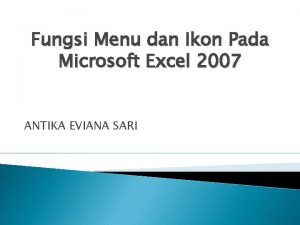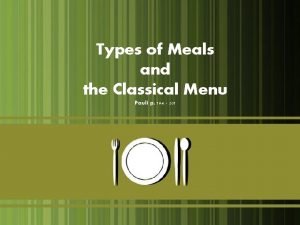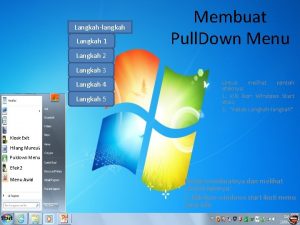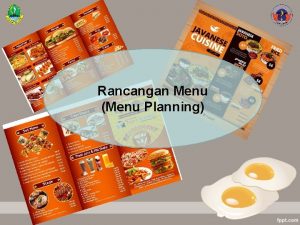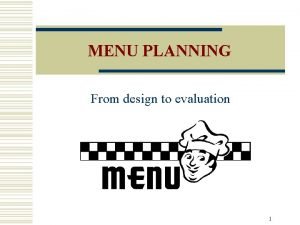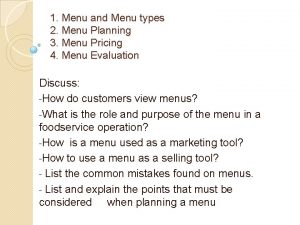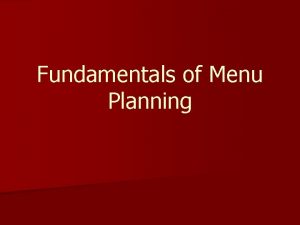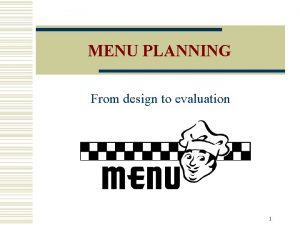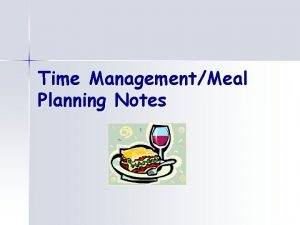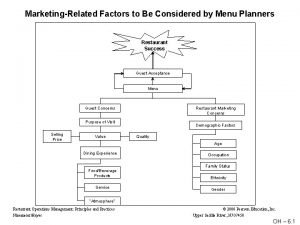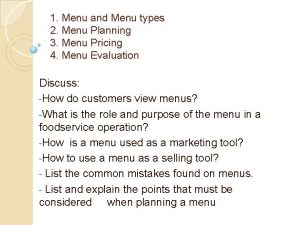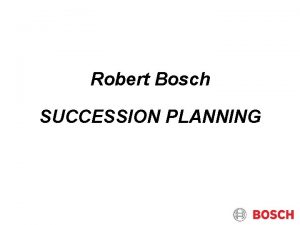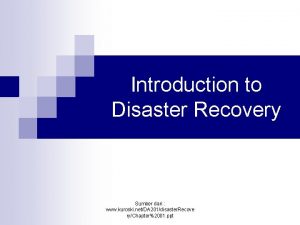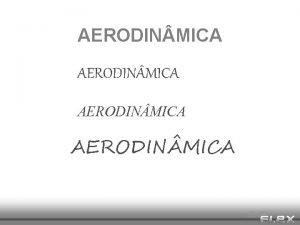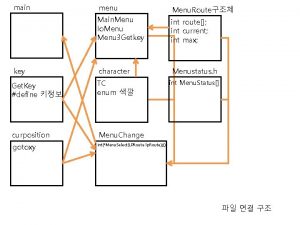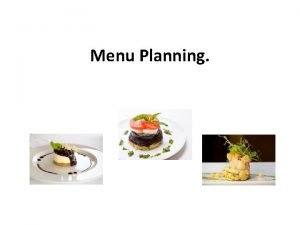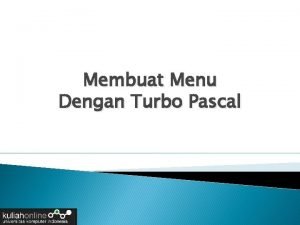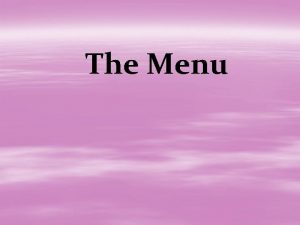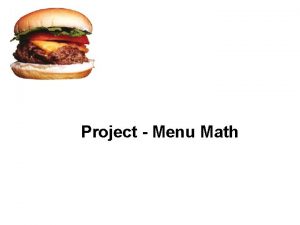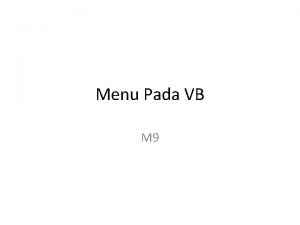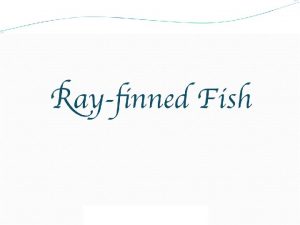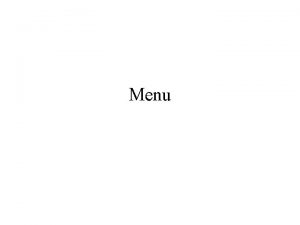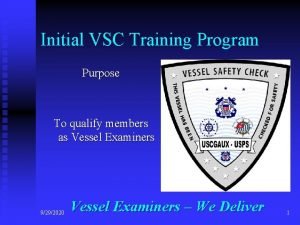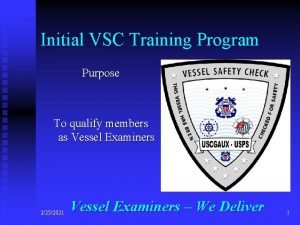Menu Planning Chapter 3 Menu Planning Principles Qualify




























- Slides: 28

Menu Planning Chapter 3

Menu Planning Principles Qualify the Client Date Number of Guests Location Budget An Off Premise Event cannot be properly planned until the location and it’s facilities are known

The More Details the Better Who are the guests? Age, Sex, Singles, Couples, etc? Special Event or celebration Any socioeconomic, ethnic or religious factors Any Foods to include or avoid Client’s likes and dislikes about previous events Association or Corporate Affiliations Budgetary Considerations – where to spend the $$$

Questions for clients Purpose of the event Is there a theme? Is there a budget? What beverages will be served Group Dynamics

Be ready to answer Recommendations on foods based on budget What type of service would be best? What is a reasonable cost for this type of event? Set up and tear down time? What is included in price (linens, tables, chairs, etc) Can I supply my own liquor? Is a guarantee required? Are special permits needed? Refund and cancellation policies.

Basic Menu Categories Seated and Served Meals – Server Family Style Buffets Food stations (or Action Stations) “Stand up” Cocktail Parties Barbeques and Picnics Combinations or variations of several

Buffets Self Service – less staffing required Variety of foods available Always must look full – must prepare more food May or may not be more expensive than plated Minimum selection should be One Salad One to two entrée choices One starch One vegetable Breads Desserts and Coffee

Food Stations Work well when the venue is spread out A Variety of International Foods are Offered When the client wants people to mingle Can be staffed or not staffed or a combination of both Can be hors d’oeuvres, Main Course or Dessert Popular Concepts include: Stir fry cooked to order Egg / Omelet Stations Fajitas, Tacos Pastas Meat Carving Stations

Stand up Cocktail Parties Either passed (or Butlered) or on buffet tables Should be bite sized Should be easy to handle with beverage Barbeques and Picnics Typically an outdoor event Can be simple or complex All Cultures have some form of BBQ

Catering Menus Federal Truth-in-Menu laws require that menus accurately describe the foods offered: Brand Names – must be used “as is” Means of Preservation – e. g. “Never Frozen”, Fresh Merchandising Terms – home style vs. homemade Point of origin – Maine Lobster, Champagne Price – all must be disclosed (service charges, etc) Product Identification – reserve the right to substitute Quality – USDA Prime, Choice, etc Quantity – 5 oz. Type or preparation

Dietary and Nutritional Claims Terms must be accurate – such as ‘Fat Free’ or ‘low sodium’ Should know all ingredients for client safety – such as allergens Also should be aware of any binders used in foods and their origins Nutritional content claims should be support by laboratory Analysis

Big “ 8” Allergens Eggs Milk (also casein, whey) Peanuts Tree nuts Fish Shellfish Soy Wheat

Menu Types Preprinted menus offer advantages such as: Client can respond quickly by reading the menu – either selecting certain items or using them to develop others Help ‘control’ clients by offering specific choices best suited to off premise catering Kitchen Staff are already familiar with the menu

Menu Types Should convey the image you want to project Should be easy to read Should include brief descriptions Use exciting words – Juicy, Succulent, Enticing, etc Spell check is just the first step – Eye Sea Wi !

Guidelines As a Rule, keep Off Premise Menus Simple Consider appropriateness of foods, textures, shapes and flavors Make it sound good! Have dual entrée selections – surf and turf, etc Do your research - visit new restaurants, etc. Good Selections include: Foods that have worked well in the past Foods that the staff have experience with Signature Dishes Feature locally grown and seasonal foods Popular Favorites Beverage Selections

Special Diets Vegans Lacto-vegetarians Ovo Lacto vegetarians Pescatarians Low fat Low cholesterol Diabetic Kosher / Halal

Food Presentation Use all 5 senses Sight Hearing Touch Smell Taste

Serving and Holding Options Keep Food Safe!!! Platters Chilled ice displays Use props from ethnic stores to serve ethnic foods For plated meals, use unusual plates and platters

Culinary Trends Even with caterers that specialize in traditional foods, such as “BBQ” or “New England Clam Bake” need to keep up on trends Trends are cyclical – yesterday’s traditions return, but frequently “with a Twist” Budget is always and ever will be important Diet and nutrition -

Trends Ethnic Cuisines Pac Rim, “Asian Fusion”, Pan Asian Indian Cuisine Latin American Cuisines Cheese Courses “Street Foods” Specialty Breads Tableside ordering -

Computing Food Quantities Involves a certain amount of guesswork Mistakes can (and will) Happen Keep Records – the past can help the present Know all you can about the client’s Guests Who – male, female, age, profession Local or Out of Town Pre or Post event ( i. e. Theater, Tailgate Party) Sophisticated or Occasional Party Goers Too Much Food is Better than Too Little ( but not TOO Much)

How Much is Enough Should be prepared for 5% to 20% extra – The larger the group the small the % overage 20 people – prepare for 24 (20%) 200 people – prepare for 215 (7. 5 %) These are general guidelines – These overages should be calculated as part of the fee.

General Guidelines Hors d’oeuvres – 4 -8 pieces pp before dinner 8 -12 pieces pp at food stations 18 -24 pieces pp – stand up dinner Large Shrimp 1 - 2 pieces butlered 4 -12 on a buffet Soup (1 st course) Salads Main Course Side Dishes Desserts

How Much is Enough - Yields Many foods require trimming – can lose up to 45 % on some foods Serving Size / Yield = Raw Portion Size Tenderloin 4 oz. / 75% = 5. 33 oz 150 guests X 5. 33 oz = 799. 5 oz / 16 = 49. 96 lbs of Tenderloin

How Much is Enough - Ordering Use recipes to calculate raw ingredients for ordering Match to the number of guests Develop Menu cards in spreadsheet format – Need knowledge of Quantity Food Preparation Techniques

Food Cost The Food Cost can be determined by multiplying the amount of each ingredient by the cost per unit Cost of the meal is the sum total of the cost of all ingredients – Don’t forget labor, props, etc. when calculating cost to the client.

Leftovers Can be risky because of food safety guidelines Throw Out Give to Client (keep accurate HACCP records, label) Reuse – Give to Charity Staff Meals (on site only) Use at companion facilities Reward helpful people (valet parkers, etc) Return to vendor

Next Class Quiz Chapter 3 Chapter 4 – Beverage Service Chapter 8 – the Show
 Defend challenge qualify
Defend challenge qualify Menu planning principles
Menu planning principles Contoh menu table d hote
Contoh menu table d hote Ikon microsoft excel
Ikon microsoft excel Meal order atau menu composition
Meal order atau menu composition Sebutkan menu yang ada pada menu bar mozilla firefox
Sebutkan menu yang ada pada menu bar mozilla firefox Langkah menu
Langkah menu Contoh menu planning
Contoh menu planning Menu planning and design
Menu planning and design Types of menus
Types of menus Types of menu planning
Types of menu planning What is menu evaluation
What is menu evaluation Menu planning notes
Menu planning notes Factors to consider in menu planning
Factors to consider in menu planning Types of menu planning
Types of menu planning Principles of succession planning
Principles of succession planning Principles of diet planning
Principles of diet planning 7 principles of planning
7 principles of planning Key principles of media planning
Key principles of media planning Principles of effective planning
Principles of effective planning Land and environment court planning principles
Land and environment court planning principles Strategic planning vs tactical planning
Strategic planning vs tactical planning Planning balance sheet in urban planning
Planning balance sheet in urban planning Role segmentation workforce planning
Role segmentation workforce planning N planning
N planning Aggregate planning is capacity planning for
Aggregate planning is capacity planning for Long medium and short term planning in primary schools
Long medium and short term planning in primary schools Language planning and policy slideshare
Language planning and policy slideshare Aggregate planning is capacity planning for
Aggregate planning is capacity planning for



